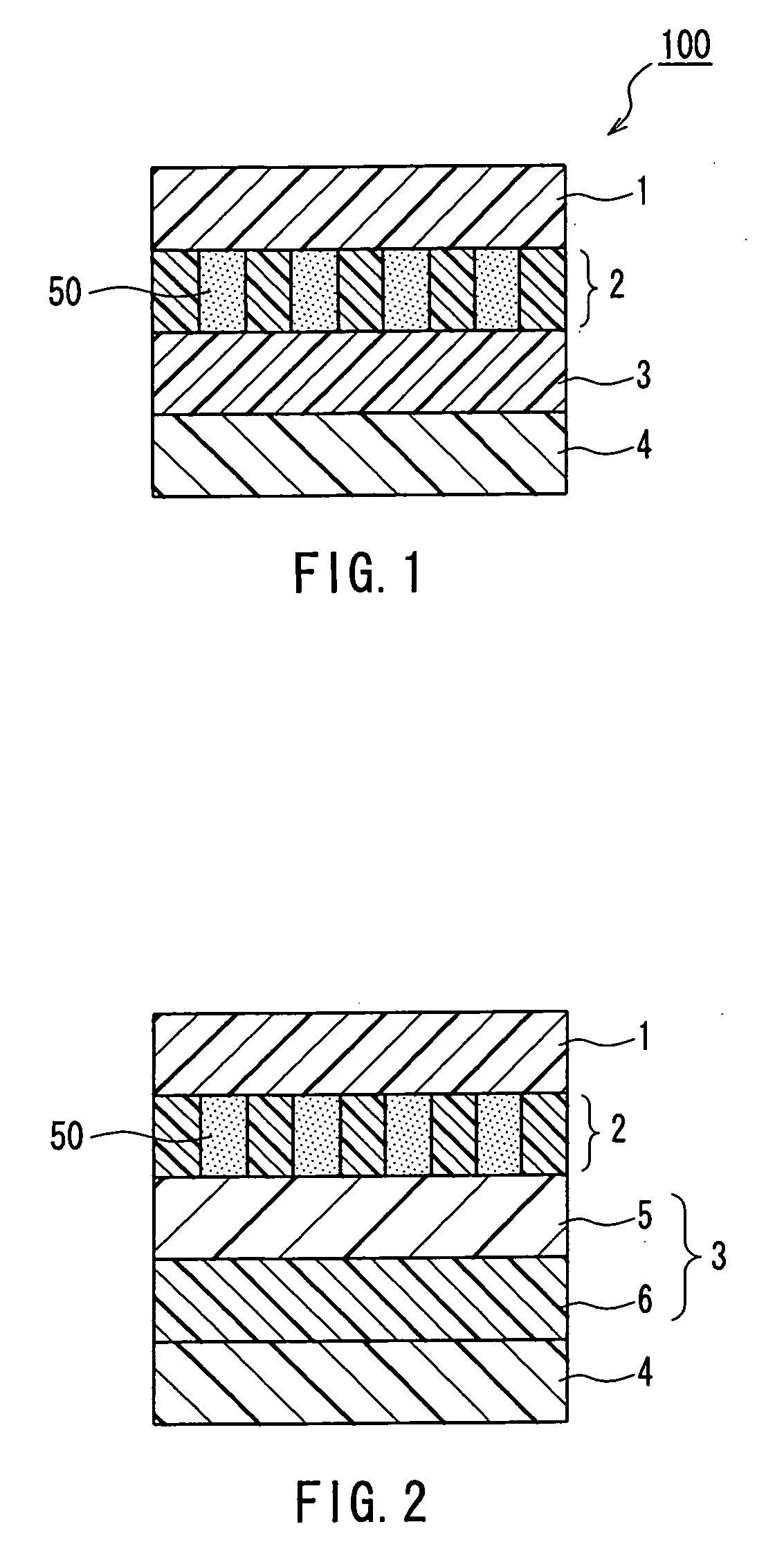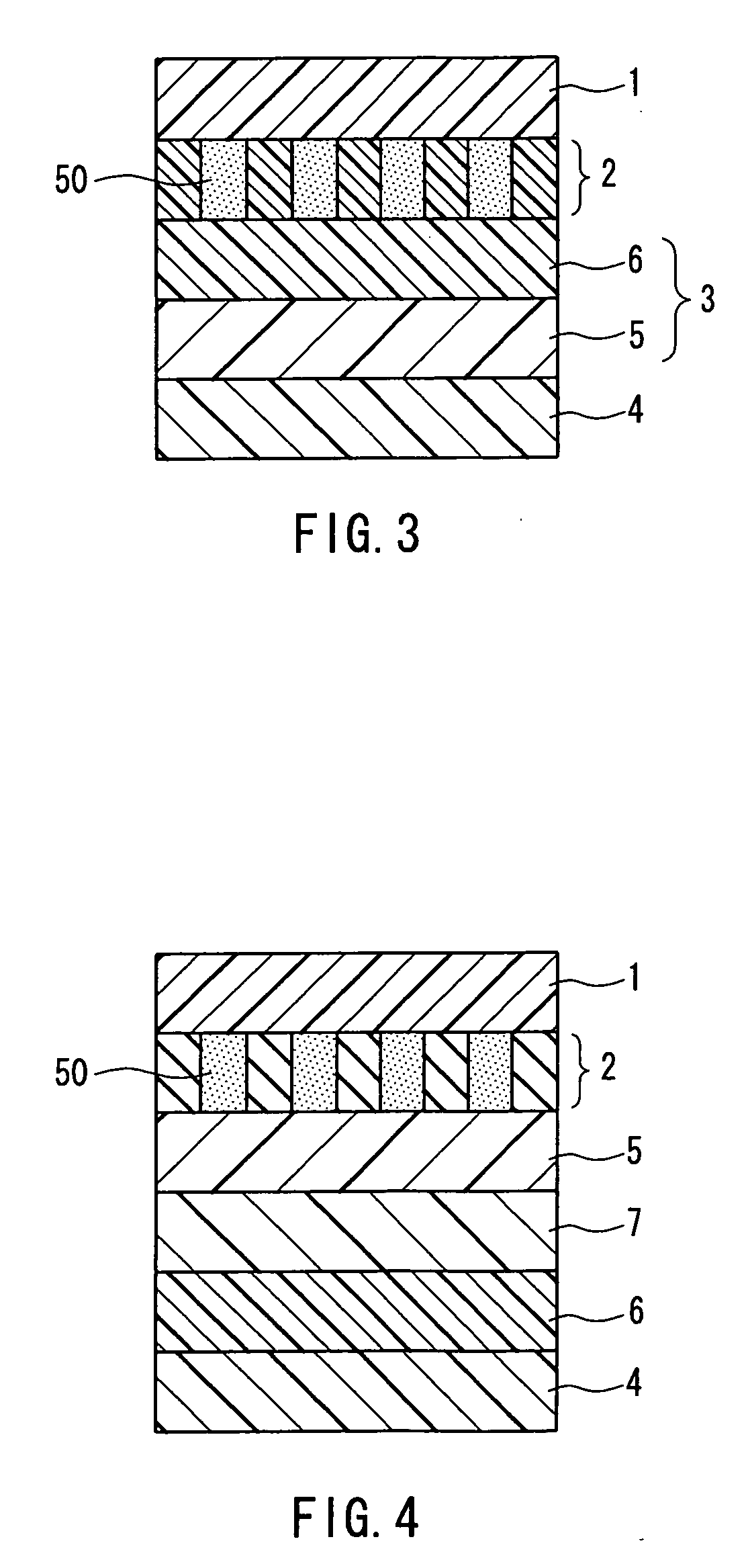Security sticker and process for producing the same
a technology for security stickers and production processes, applied in the field of security stickers, can solve the problems of deteriorating image sharpness, affecting the detection of stolen cars, and increasing the number of thefts of vehicle identifying stickers, so as to enhance counterfeit prevention effect, improve image sharpness, and improve the effect of transparency
- Summary
- Abstract
- Description
- Claims
- Application Information
AI Technical Summary
Benefits of technology
Problems solved by technology
Method used
Image
Examples
embodiment 1
[0189]FIG. 1 is a cross-sectional view showing an example of the first security sticker of the present invention. The security sticker 100 includes a surface resin layer (A)1, a print layer (B)2, a self-destructive film layer (C1)3 and a pressure-sensitive adhesive layer (D1)4 that are laminated in this order. The print layer (B)2 includes a dyeing layer 50 in which a sublimable dye is fixed, and an image is formed in a thickness direction by this dyeing layer 50.
[0190] The print layer (B)2 is a layer containing a low-molecular-weight compound that has a molecular weight of 1300 or less, preferably has a molecular weight of 2000 or less, and more preferably has a molecular weight of 3000 or less, in an amount of 0% to 20 wt % inclusive. This is because the low-molecular-weight compound gradually can diffuse the once-fixed sublimable dye, and as a result, a problem occurs such as the deterioration of the sharpness of an edge of the image in the print layer (B)2. In addition, the con...
reference example 1
[0220] 1000 parts of n-butyl acetate was put in a four-necked flask equipped with a stirrer, a thermometer, an inert-gas inlet and a condenser, and then a temperature was increased to 110° C. Next, a mixture containing: 650 parts of methyl methacrylate; 245 parts of n-butyl methacrylate; 100 parts of 2-hydroxyethyl methacrylate; 5 parts of methacrylic acid; and 15 parts of t-butylperoxy-2-ethyl hexanoate was dropped at 110° C. over the course of 4 hours. After the dropping, the temperature was kept at 110° C. so as to continue the reaction for 6 hours, thereby obtaining an acrylic copolymer (a-1) with a nonvolatile content of about 50%. After the thus obtained acrylic copolymer (a-1) was dried, its SP value was measured, which was 10.16.
reference examples 2 to 6
[0221] Acrylic copolymers (a-2) to (a-6) were obtained in the same manner as Reference Example 1 except that the ratio of the vinyl monomers was changed to the ratios as shown in Table 1. In addition, their SP values measured after the drying are shown in Table 1.
TABLE 1Vinyl monomers (parts)a-2a-3a-4a-5a-6styrene100200—200—methyl methacrylate200500800—400ethyl methacrylate200——450—ethyl acrylate——190—100n-butyl methacrylate100200——300t-butyl methacrylate———200—n-butyl acrylate195 95—1501902-hydroxyethyl methacrylate200————methacrylic acid 5 5 10— 10S P values 9.79 9.64 10.49 9.02 9.54
[0222] It is preferable to use, as the dye migration preventive resin layer (E)5, a resin containing such acrylic resins as main components in an uncured state, or a three-dimensionally structured polymer that is obtained by crosslinking an acrylic resin having a reactive functional group with a curable material that reacts with this reactive functional group, because the migration of the s...
PUM
| Property | Measurement | Unit |
|---|---|---|
| shrinkage ratio | aaaaa | aaaaa |
| shrinkage ratio | aaaaa | aaaaa |
| Tg | aaaaa | aaaaa |
Abstract
Description
Claims
Application Information
 Login to View More
Login to View More - R&D
- Intellectual Property
- Life Sciences
- Materials
- Tech Scout
- Unparalleled Data Quality
- Higher Quality Content
- 60% Fewer Hallucinations
Browse by: Latest US Patents, China's latest patents, Technical Efficacy Thesaurus, Application Domain, Technology Topic, Popular Technical Reports.
© 2025 PatSnap. All rights reserved.Legal|Privacy policy|Modern Slavery Act Transparency Statement|Sitemap|About US| Contact US: help@patsnap.com



